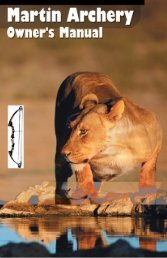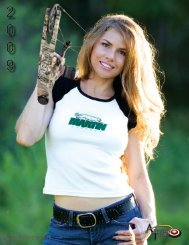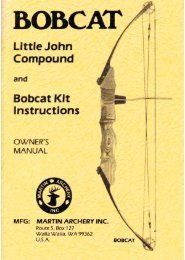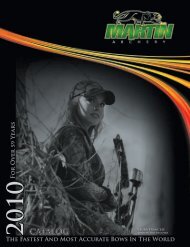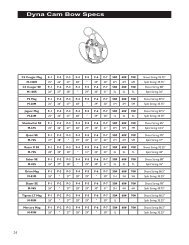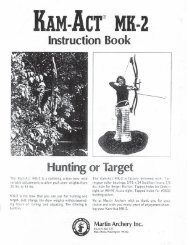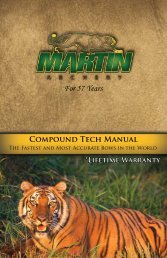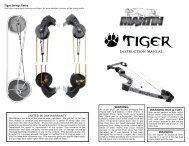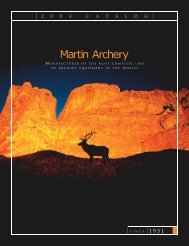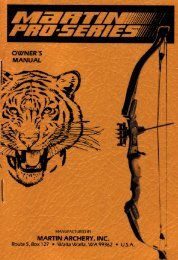RECURVE / LONGBOW OWNERS MANUAL - Martin Archery
RECURVE / LONGBOW OWNERS MANUAL - Martin Archery
RECURVE / LONGBOW OWNERS MANUAL - Martin Archery
You also want an ePaper? Increase the reach of your titles
YUMPU automatically turns print PDFs into web optimized ePapers that Google loves.
STRINGING YOUR BOW<br />
<strong>Martin</strong> <strong>Archery</strong> recommends that you use a bowstringer<br />
when stringing your bow. Proper use of a bowstringer will<br />
prevent your bow’s limbs from becoming twisted. A<br />
bowstringer also provides the safest method of stringing your<br />
bow as the limb tips are away from you during the stringing and<br />
unstringing process. (Avoid placing your head close to the limb<br />
tips when stringing and unstringing your bow).<br />
ARROW REST<br />
All <strong>Martin</strong> (Howatt) bows, with the exception of<br />
traditional longbow models, are designed to be shot either from<br />
an elevated arrow rest or directly off of the arrow shelf. An<br />
elevated arrow rest provides increased fletching clearance<br />
and is helpful when using plastic vanes. Shooting off of the<br />
shelf allows the arrow to be held closer to the bow hand which<br />
is helpful to instinctive shooting. It is recommended, when<br />
shooting off of the shelf, that you pad the arrow shelf and the<br />
portion of the sight window directly above the pivot point<br />
with a rug rest or hair rest.<br />
Hair (rug) Rest<br />
Elevator Rest<br />
ARROWS<br />
All types of arrows (wood, aluminum, carbon) can be shot from your <strong>Martin</strong><br />
(Howatt) bow. Regardless of arrow type, it is important that your arrows are correctly spined<br />
(have the correct spine stiffness) for your draw weight. Check your arrow manufacturers<br />
recommendations to determine the arrow size best suited for your bow.<br />
BRACE HEIGHT (FISTMELE)<br />
The brace height of your bow is measured from the pivot point, or most inward<br />
point of the grip, to the bowstring (see illustration, front page).<br />
The recommended brace height for your bow is listed:<br />
•Bamboo Viper, ML-4 7" - 7 3/4"<br />
•Dream Catcher, 2805 7 1/4" - 8"<br />
•Hatfield TD, 2814 7 1/4" - 8"<br />
•Hunter, 2800 7" - 7 3/4"<br />
•Mamba, 2370 7" - 7 3/4"<br />
•Jaguar TD, 2816 7" - 7 1/2"<br />
•Rebel, 2184 6 1/4" - 7"<br />
•Savannah, ML-4 6 1/4" - 7"<br />
•Stick, ML-9 6" - 6 3/4"<br />
•Venom, 2372 7" - 7 3/4"<br />
•L-100 7 1/4" - 7 3/4"<br />
•X-150 8 1/4" - 8 3/4"<br />
•X-200 7 3/4" - 8 1/2"<br />
A higher brace height helps reduce bow vibration and noise and also minimizes<br />
the effects of shooting errors. A lower brace height provides increased arrow velocity.<br />
Increased noise and poor arrow flight can be the result of a brace height that is too low.<br />
Twisting your bowstring will reduce its length and increase your brace height.<br />
Untwisting your bowstring or installing a longer bowstring will decrease your brace height.<br />
(Avoid untwisting flemish style bowstrings as string failure may occur). Experiment to<br />
find the brace height measurement that allows your bow to perform at its best with your<br />
particular style of shooting.



